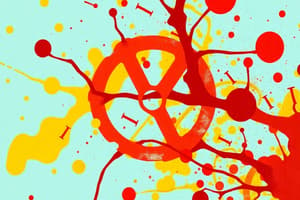Podcast
Questions and Answers
Which chemical contaminant is associated with cookware?
Which chemical contaminant is associated with cookware?
- Mercury
- PFOA (correct)
- PBDEs
- BPA
Which chemical contaminant is commonly found in fire retardants?
Which chemical contaminant is commonly found in fire retardants?
- Dioxins
- PCBs
- PBDEs (correct)
- Mercury
Which contaminant results from the manufacture of vinyl chloride?
Which contaminant results from the manufacture of vinyl chloride?
- PCBs (correct)
- Methylmercury
- PFOA
- PBDEs
Which contaminant is primarily linked to old transformers?
Which contaminant is primarily linked to old transformers?
Which of these is not typically a common food allergen?
Which of these is not typically a common food allergen?
What is the primary substance causing Celiac disease?
What is the primary substance causing Celiac disease?
Which contaminant is primarily derived from the use of certain plastic products?
Which contaminant is primarily derived from the use of certain plastic products?
Which type of food is least likely to trigger an immune response in sensitive individuals?
Which type of food is least likely to trigger an immune response in sensitive individuals?
Mercury contamination is primarily associated with which type of food?
Mercury contamination is primarily associated with which type of food?
Which of the following is an example of an unintentional chemical contaminant?
Which of the following is an example of an unintentional chemical contaminant?
Which persistent organic pollutant is NOT banned by the Stockholm Convention?
Which persistent organic pollutant is NOT banned by the Stockholm Convention?
Which of the following best describes bioaccumulation?
Which of the following best describes bioaccumulation?
Which of the following contaminants is specifically derived from smoking and charring food?
Which of the following contaminants is specifically derived from smoking and charring food?
Which heavy metal is NOT commonly mentioned among chemical contaminants?
Which heavy metal is NOT commonly mentioned among chemical contaminants?
What is a significant risk factor associated with using Teflon cookware?
What is a significant risk factor associated with using Teflon cookware?
Which of the following is a method by which pollutants increase in concentration in a food chain?
Which of the following is a method by which pollutants increase in concentration in a food chain?
Which of the following is NOT a type of planned chemical contamination mentioned?
Which of the following is NOT a type of planned chemical contamination mentioned?
Which of the following substances is considered a persistent organic pollutant (POP)?
Which of the following substances is considered a persistent organic pollutant (POP)?
What does bioamplification refer to in the context of environmental pollutants?
What does bioamplification refer to in the context of environmental pollutants?
Which of the following is classified as an unintentional chemical contaminant?
Which of the following is classified as an unintentional chemical contaminant?
What type of toxic exposure can endocrine disruptors potentially cause?
What type of toxic exposure can endocrine disruptors potentially cause?
Which of the following is NOT mentioned as a heavy metal commonly impacting food safety?
Which of the following is NOT mentioned as a heavy metal commonly impacting food safety?
Which harmful chemical is associated with the use of certain Teflon cookware?
Which harmful chemical is associated with the use of certain Teflon cookware?
Which of the following is considered a type of intentional chemical contaminant?
Which of the following is considered a type of intentional chemical contaminant?
What are sodium nitrates and nitrites suspected to form during cooking?
What are sodium nitrates and nitrites suspected to form during cooking?
Which chemical contaminant is primarily derived from plasticizers used in food packaging?
Which chemical contaminant is primarily derived from plasticizers used in food packaging?
What type of substance is categorized as an allergen?
What type of substance is categorized as an allergen?
Which chemical contaminant is linked primarily to fire-retardant materials?
Which chemical contaminant is linked primarily to fire-retardant materials?
What is a primary concern regarding the consumption of fish and seafood?
What is a primary concern regarding the consumption of fish and seafood?
Which allergen is specifically linked to gluten intolerance?
Which allergen is specifically linked to gluten intolerance?
Which chemical contaminant has been banned in many countries due to its toxic impacts on the environment?
Which chemical contaminant has been banned in many countries due to its toxic impacts on the environment?
Which type of food is least likely to contain common allergens?
Which type of food is least likely to contain common allergens?
Flashcards
Cookware contaminant
Cookware contaminant
A chemical contaminant found in cookware materials
Fire retardant contaminant
Fire retardant contaminant
A chemical contaminant found in fire retardant materials.
Vinyl chloride contaminant
Vinyl chloride contaminant
A chemical contaminant from vinyl chloride manufacturing.
Old transformer contaminant
Old transformer contaminant
Signup and view all the flashcards
Allergen
Allergen
Signup and view all the flashcards
Peanut allergen
Peanut allergen
Signup and view all the flashcards
Nut allergen
Nut allergen
Signup and view all the flashcards
Fish/Shellfish allergen
Fish/Shellfish allergen
Signup and view all the flashcards
Egg allergen
Egg allergen
Signup and view all the flashcards
Intentional Chemical Contaminants
Intentional Chemical Contaminants
Signup and view all the flashcards
Milk allergen
Milk allergen
Signup and view all the flashcards
Unintentional Chemical Contaminants
Unintentional Chemical Contaminants
Signup and view all the flashcards
Persistent Organic Pollutants (POPs)
Persistent Organic Pollutants (POPs)
Signup and view all the flashcards
Bioaccumulation
Bioaccumulation
Signup and view all the flashcards
Biomagnification/Bioamplification
Biomagnification/Bioamplification
Signup and view all the flashcards
Heavy Metals
Heavy Metals
Signup and view all the flashcards
Methylmercury
Methylmercury
Signup and view all the flashcards
Pesticides
Pesticides
Signup and view all the flashcards
Sodium Nitrates/Nitrites
Sodium Nitrates/Nitrites
Signup and view all the flashcards
Polyaromatic Hydrocarbons (PAHs)
Polyaromatic Hydrocarbons (PAHs)
Signup and view all the flashcards
Intentional Contaminants
Intentional Contaminants
Signup and view all the flashcards
Unintentional Contaminants
Unintentional Contaminants
Signup and view all the flashcards
Persistent Organic Pollutants (POPs)
Persistent Organic Pollutants (POPs)
Signup and view all the flashcards
Bioaccumulation
Bioaccumulation
Signup and view all the flashcards
Biomagnification
Biomagnification
Signup and view all the flashcards
Heavy Metals
Heavy Metals
Signup and view all the flashcards
Methylmercury
Methylmercury
Signup and view all the flashcards
Pesticides
Pesticides
Signup and view all the flashcards
Sodium Nitrates/Nitrites
Sodium Nitrates/Nitrites
Signup and view all the flashcards
Polyaromatic Hydrocarbons (PAHs)
Polyaromatic Hydrocarbons (PAHs)
Signup and view all the flashcards
Cookware contaminant
Cookware contaminant
Signup and view all the flashcards
Fire retardant contaminant
Fire retardant contaminant
Signup and view all the flashcards
Vinyl chloride contaminant
Vinyl chloride contaminant
Signup and view all the flashcards
Old transformer contaminant
Old transformer contaminant
Signup and view all the flashcards
Allergen
Allergen
Signup and view all the flashcards
Food Allergens
Food Allergens
Signup and view all the flashcards
Chemical Contaminants
Chemical Contaminants
Signup and view all the flashcards
Health Hazards
Health Hazards
Signup and view all the flashcards
Protection from Health Hazards
Protection from Health Hazards
Signup and view all the flashcards
Different Kinds of Toxins
Different Kinds of Toxins
Signup and view all the flashcards
Study Notes
Food Gone Bad: Part 2
- Chemical Contaminants: Food can be contaminated unintentionally (industrial waste) or intentionally (pesticides, etc.)
Unintentional Contaminants
- Heavy metals: Mercury, methylmercury, other heavy metals (e.g., Al, Pb, As, Cd)
- Fire retardants (PBDEs)
- Polychlorinated biphenyls (PCBs) and related compounds (furans)
Intentional Contaminants
- Pesticides: Insecticides (organochlorines like dioxin, DDT, organophosphates, carbamates), Fungicides, Herbicides (e.g., 2,4-D, atrazine, glyphosate)
- Hormones: Synthetic estrogens (rBGH, or rBST)
Persistent Organic Pollutants (POPs)
- POP characteristics: long-lasting in the environment, widely distributed, damage to humans and ecosystems
- Health effects of POPs: Cancer, allergies, hypersensitivity, damage to the central and peripheral nervous systems, endocrine disrupters affecting development, reproductive system, and immune systems
- Banned POPs (since 2004): Certain pesticides (like DDT), industrial chemicals and their by-products, e.g., PBDEs, PCBs, dioxins, furans, PFOA
Bioaccumulation and Biomagnification
- POPs and heavy metals: Absorbed by organisms
- Bioaccumulation: Build-up of pollutant in tissues/organs
- Biomagnification: Concentration of substances increases as it goes up the food chain
- Mercury: Example of Bioaccumulation/Biomagnification
- Mercury builds up in organisms, and the concentration increases in higher organisms on the food chain
Toxins from Cooking and Packaging
- Sodium nitrites and nitrates (nitrosamines)
- Polyaromatic hydrocarbons (PAHs) from smoking/charring
- Plastic monomers and additives (phthalates): Bisphenol-A (BPA), in polycarbonate plastics and epoxy resins
- PFOA (perfluorooctanoic acid) in Teflon cookware
Test Review Questions
- Question 1: Mercury is NOT an intentional contaminant.
- Question 2: Antibiotics are NOT an unintentional contaminant.
- Question 3: PFOA comes from cookware.
- Question 4: PBDEs come from fire retardants.
- Question 5: Methylmercury comes from vinyl chloride manufacture.
- Question 6: Methylmercury comes from old transformers.
Allergens
- Allergens: Substances normally safe to eat, but trigger anomalous immune responses in some people
- Common food allergens: Peanuts, tree nuts, soy, fish, shellfish, crustaceans, eggs, milk, gluten (in wheat, barley, rye, and oat products)
Review Exercise
- Examines different contaminants in food/water and preventative measures.
Studying That Suits You
Use AI to generate personalized quizzes and flashcards to suit your learning preferences.
Related Documents
Description
Test your knowledge on the chemical contaminants found in food, both unintentional and intentional. Explore the effects of heavy metals, pesticides, and persistent organic pollutants on health and the environment. Understand the implications of these contaminants on food safety.




